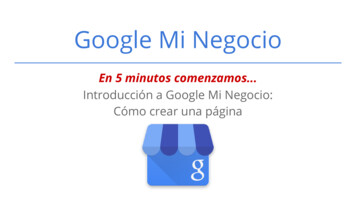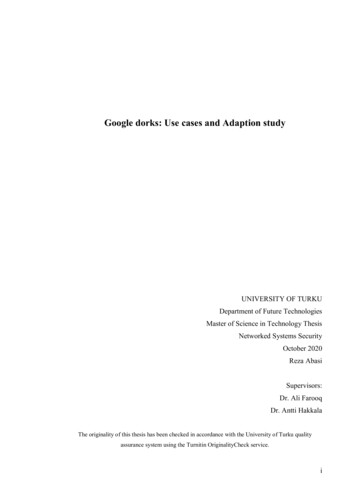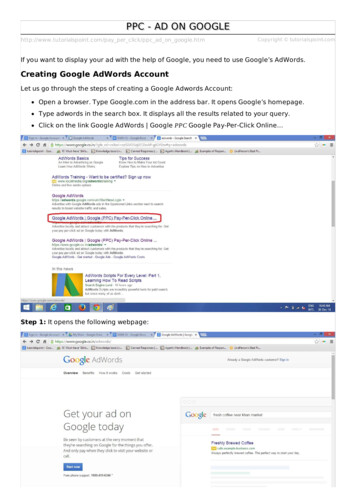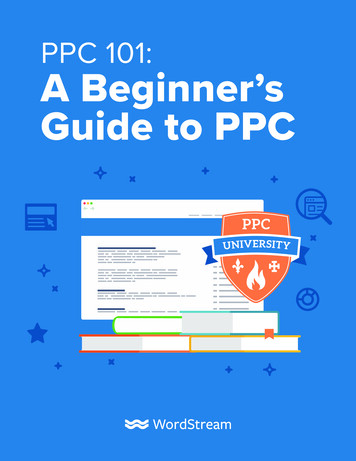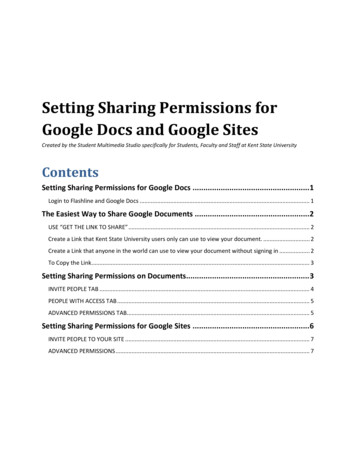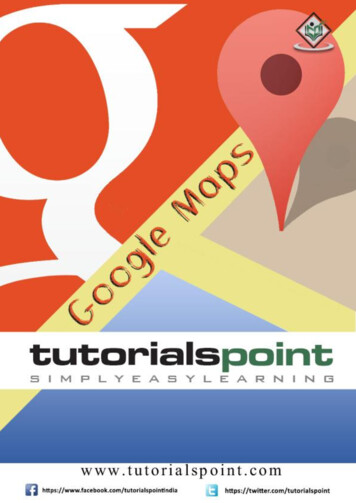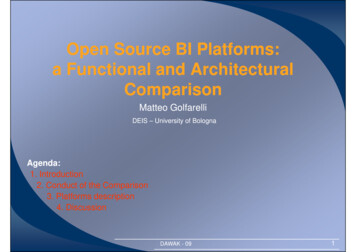
Transcription
Emerald FullText Article : Google Scholar revisited19/05/09 13:07Google Scholar revisitedThe AuthorsPéter Jacsó, University of Hawaii, Hawaii, USAAbstractPurpose – The purpose of this paper is to revisit Google Scholar.Design/methodology/approach – This paper discusses the strengths and weaknesses of Google Scholar.Findings – The Google Books project has given a massive and valuable boost to the already rich and diverse contentof Google Scholar. The downside of the growth is that significant gaps remain for top ranking journals and serials, andthe number of duplicate, triplicate and quadruplicate records for the same source documents (which Google Scholarcannot detect reliably) has increased.Originality/value – This paper discusses the strengths and weaknesses of Google Scholar.Article Type: General reviewKeyword(s): Data collection; Worldwide web; Document delivery.Journal: Online Information ReviewVolume: 32Number: 1Year: 2008pp: 102-114Copyright Emerald Group Publishing LimitedISSN: 1468-4527Google Scholar had its debut in November 2004. Although it is still in beta version, it is worthwhile to revisit its prosand cons, as changes have taken place in the past three years both in the content and the software of GoogleScholar – for better or worse.Its content has grown significantly [dash ]– courtesy of more academic publishers and database hosts opening theirdigital vaults to allow the crawlers of Google Scholar to collect data from and index the full-text of millions of articlesfrom academic journal collections and scholarly repositories of preprints and reprints. The Google Books project alsohas given a massive and valuable boost to the already rich and diverse content of Google Scholar. The downside ofthe growth is that significant gaps remained for top ranking journals and serials, and the number of duplicate, triplicateand quadruplicate records for the same source documents (which Google Scholar cannot detect reliably) hasincreased.While the regular Google service does an impressive job with mostly unstructured web pages, the software of GoogleScholar keeps doing a very poor job with the highly structured and tagged scholarly documents. It still has seriousdeficiencies with basic search operations, does not have any sort options (beyond the questionable relevance ranking).It offers filtering features by data elements, which are present only in a very small fraction of the records (such asbroad subject categories) and/or are often absent and incorrect in Google Scholar even if they are present correctly inthe source items.These include nonexistent author names, which turn out to be section names, subtitles, or any part of the text,including menu option text which has nothing to do with the document or its author. This makes “F. Password” not onlythe most productive, but also a very highly cited author. Page numbers, the first or second segment of an ISSN, or anyother four-digit numbers are often interpreted by Google Scholar as publication years due to “artificial unintelligence”.As a consequence, Google Scholar has a disappointing performance in matching citing and cited items; its hit countsand citation counts remain highly inflated, defying the most basic plausibility concepts when reporting about documentsfrom the 1990s citing papers to be published in 2008, 2009 or even later in the twenty-first century.In spite of the deficiencies and shoddiness of its software the free Google Scholar service is of great help in theresource discovery process and can often lead users to the primary documents in their library in print or digital formatand/or to open access versions of papers which otherwise would cost more than 30- 40 each through documentdelivery services. Google Scholar can act at the minimum as a free, huge and diverse multidisciplinary I/A database ora federated search engine with limited software capabilities, but with the superb bonus of searching incredibly rapidlythe full-text of several million source documents. However, using it for bibliometric and scientometric evaluation,comparison and ranking purposes can produce very unscholarly measures and indicators of scholarly productivity ewContentServlet;jsessioni Filename 08.htmlPagina 1 di 12
Emerald FullText Article : Google Scholar revisited19/05/09 13:07Background and literatureOn the third anniversary of Google Scholar I give a summary of the pros and cons of Google Scholar, focusing on theincreasingly valuable content and on the decreasingly satisfactory software features which must befuddle searchersand ought to be addressed by the developers. I discuss here Google Scholar from the perspective of some of thetraditional database evaluation criteria that have been used for decades (Jacsó, 1998). I complement this paper withan unusually long bibliography of some of the most relevant English-language articles by competent informationprofessionals. For many of the citations I provide the URL of an open access preprint or reprint version, or of theoriginal version published in an open access journal, to offer readers convenient access to the papers and understandthe opinion of the authors. Re-reading these papers in preparation for this review was a great pleasure, even when myopinion did not agree with that of the reviewers. The balance of pro and con arguments and evidentiary materialspresented by competent information professionals has been rewarding and has motivated my creation of thisbibliography. It does not include references to papers which are dedicated to the citation counts of articles aspresented by Google Scholar. These will be provided in follow-up papers which discuss the strengths and weaknessesof using Scopus, Web of Science and Google Scholar to determine the Hirsch-index and derivative indexes formeasuring and comparing research output quantitatively.After the launch of Google Scholar it received much attention, just as anything does that relates to Google, Inc. Withinthe first few months of its debut, there were a number of reviews in open access web columns (Price, 2004; Jacsó,2004; Goodman, 2004; Gardner and Eng, 2005; Abram, 2005; Tenopir, 2005), and three web blogs were launcheddedicated to Google Scholar (Sondemann, 2005; Giustini, 2005), or partially dedicated (Iselid, 2006).These were followed by reviews in traditional publications (Jacsó, 2005a; Myhill, 2005; Notess, 2005, O'Leary, 2005,Giustini and Barsky, 2005; Noruzi, 2005; Adlington and Benda, 2006; Cathcart and Roberts, 2006) focussing on thecontent and software aspects of Google Scholar. These were well complemented by a number of essays, editorialsand surveys pondering the acceptance, use, promotion and “domestication” of Google Scholar as one of the endorsedresearch tools for students and faculty in academic institutions (Kesselman and Watsen, 2005; Price, 2005; Anderson,2006; Gorman, 2006; Mullen and Hartman, 2006; Friend, 2006; Hamaker and Spry, 2006; York, 2006; Helms-Park etal., 2007; Schmidt, 2007; Taylor, 2007).As Google Scholar became more intensively used, several research papers started to put it into context by comparingGoogle Scholar's performance with a single database (Schultz, 2007), federated search engines (Felter, 2005; Giustiniand Barsky, 2005; Chen, 2006; Sadeh, 2006; Donlan and Cooke, 2006; Haya et al., 2007; Herrera, 2007), citationenhanced databases such as Web of Science and/or Scopus (Bauer and Bakkalbasi, 2005; Jacsó, 2005b; Jacsó,2005c; Yang and Meho, 2006; Norris and Oppenheim, 2007), or with a mix of these and traditional scholarlyindexing/abstracting databases (White, 2006).There is increasing specialisation in researching Google Scholar, applying the traditional database evaluation criteriasuch as size, timeliness, source type and especially breadth of journal coverage (Jacsó, 1997) in a consistent mannerin the context of a very non-traditional database which piggybacks on other sources rather than creating its own(Wleklinksi, 2005; Vine, 2005; Vine, 2006; Neuhaus et al., 2006; Pomerantz, 2006; White, 2006; Mayr and Walter,2007; Walters, 2007).The recent incorporation of books in Google Scholar from Google Book Search (which after a poor debut with deficientsoftware features, turned around and introduced within a month far more sophisticated software than Google Scholarin three years), spawned useful research (Hauer, 2006; Lackie, 2006; Goldeman and Connolly, 2007), as did the onlygood new software feature of Google Scholar which led users to the full-text digital source document in the users'library through Open-URL resolvers (Grogg and Ferguson, 2005; O'Hara, 2007; Lagace and Chisman, 2007).There is one additional research area where Google Scholar will play an important role: its use for bibliometric andscientometric evaluation of the performance of researchers, which is such a complex issue that it deserves to bediscussed in a separate paper, with its own rich set of references.The prosMost of the pros relate to the content part of Google Scholar, from different angles, including coverage, variety insource and journal base, size and currency.Journal coverageThe source base of Google Scholar has been considerably enhanced since its debut, as every scholarly publisherwants to be a part of the Google universe. The source base also increased in quality through full-text indexing ofthousands of additional academic journals of importance from the sites of the publishers, rather than just indexingbibliographic data and abstract from I/A databases. The two most important journal publishers that started to cooperate with Google Scholar are Elsevier and the American Chemical Society. Although only a tiny proportion of thesepublishers' digital collections (Elsevier's 7 million items and the ACS's 0.75 million items) have been indexed so far byGoogle Scholar, their shares are expected to increase rapidly once the Google Scholar spiders are sent to their ontentServlet;jsessioni Filename 08.htmlPagina 2 di 12
Emerald FullText Article : Google Scholar revisited19/05/09 13:07Book coverageIt was an excellent idea to add book records to Google Scholar, primarily from the Google Books Project. It is a hugeadvantage, as books are barely present even as an indexing/abstracting record, let alone as a completely indexed, fulltext item (for searching, not viewing) in most of the other multidisciplinary mega-databases (except for the also freeand outstanding Amazon.com site). In preparing for a tutorial session in Vietnam, it was impressive to find 27 books inGoogle Scholar, each of which had numerous passages about or references to the so-called “scholar gentry class”.This is the type of casual digital book use that the late Frederick Kilgour, the founder of OCLC envisioned more than20 years ago, when he was already in his early 70s.Geographic and language coverageThe geographic and language coverage of Google Scholar is also impressive and genuine. It is a typical limitation ofeven the subscription-based scholarly databases that they often almost exclusively cover only anglophone sources,predominantly published in the USA, UK, Australia and Canada (in which case francophone documents are alsocovered). I do not blame the commercial database publishers for this, as they were not created on the same principlesas the UN or UNESCO. They have to spend their money on processing documents which are of interest to andunderstandable by the majority of scholars, their primary customers.The Google Scholar service does not have the ever-increasing costs of subscription and human processing of thescholarly print publications. It has free access to practically any scholarly digital document collection it wants, andwisely has decided to index (by software) important Spanish, Portuguese, German, Japanese, Chinese, Korean andRussian language collections of academic works. While the latter four are of no help to me, the former three are andare worth the extra mental effort to read in the native language, as there are several sources in my areas ofspecialisation where researchers in Germany, Austria, the Iberian peninsula, Central and South America (especiallyBrazil), that publish only in German, Spanish and Portuguese.I have avoided referring to the actual size of Google Scholar and its subsets, as it is impossible to determine a realisticnumber, or even estimate the number of records in the database, or in the Canadian subset or the language subsets.Digital repositoriesThe coverage of digital repositories – even if far from complete – is already a great asset, especially for physics,astrophysics, medicine, economics and computer and information sciences and technology. But the use of such fulltext repositories still could be significantly improved. For example, only about a quarter of the open access PubMedCentral (PMC) items are directly available in Google Scholar. True, there are records in Google Scholar – from othersources, such as cababstractsplus.org – for many more of the 620,000 full text documents deposited in PMC.It would, however, be essential to index the source documents and give them priority in displaying the result listclearly, marking them as open access, instead of giving undeserved prominence to the British Library documentdelivery service (BL Direct), which is more than happy to charge for document delivery even when the open accesspaper is just a click away from the user. Just as quickly as Google Scholar can determine whether a journal isavailable for article delivery through the British Library, it could determine whether it is available free of charge fromruns of open access issues of the journal. The same is true for the open access full-text subset of the NationalTransportation Library (which has, for example, more than 100 documents about transport-related terrorism). In sharpcontrast Google Scholar has only a dozen source documents indexed and made available from that site.While praising the broad content coverage of Google Scholar, it must be noted that there are still huge gaps in the fulltext indexing of the most important serial publications as mentioned in the original review (Jacsó, 2005a). For example,less than 17 per cent of the 430,500 documents at the nature.com web site were indexed by Google Scholar directlyfrom that site (which includes not only Nature magazine but also many other journals of the Nature Publishing Group).True, many more than 17 per cent of them have a record in Google Scholar, but many of these are just citationrecords with minimal information.Indexing/abstracting recordsIt is good that there are millions of records from good indexing/abstracting databases for documents for which digitalfull text is not yet available. However, Google Scholar should have used the unique privilege granted by thousands ofscholarly publishers of gaining permission to crawl and index the full text of the primary documents, rather than just theersatz records, often redundantly through several indexing/abstracting databases.SizeI usually start the content review by determining the size of the database, and its distinct subsets. It is essential forresearchers to know how many records are in Google Scholar in total, and/or in, say, English or Spanish, whichjournals are covered from what publishers for what time span, but its developers “take the Fifth” when asked about tServlet;jsessioni Filename 08.htmlPagina 3 di 12
Emerald FullText Article : Google Scholar revisited19/05/09 13:07or about any factual features of the database (such as the number of journals, publishers, foreign language materials,articles, conference papers, reports, books covered). My various “sizing up” queries do not work so it would beirresponsible to report them.The only good new features in the software are the Library Links and Library Search options. These inform userswhether their library offers access to the document in question. If your library signed up (and provided data about itsdigital journal holdings) to Google Scholar this would work automatically (if Google Scholar is invoked from the libraryor a computer with authenticated IP address, or remotely through the library, after the appropriate login process). TheLibrary Search option for books works if the library is an OCLC member. It is to be noted that the [BOOK] label in theGoogle Scholar result lists often refers to a review of, or blurb about, the book rather than the book itself.The consPractically all the major negative traits of Google Scholar are caused by or relate to software issues. As indicatedabove, it is impossible even to guess the size of the database because of elementary problems with the software.InnumeracyIt speaks volumes about the limitations of the software that when using the query term the (the most commonlyoccurring English word), Google Scholar yields a hit count of over 1.5 billion records, whether you are using it with orwithout the sign or surround it by double quotation marks (as it is supposed to be a stop word without these signs,but apparently it is not). I do not believe this hit count to be true, but that is not the point here (see Figure 1).If you add (out of curiosity) the letter “a” in an OR relationship, the result set should increase by picking up records forforeign language source documents which use the letter a as the definite article and/or a preposition. In the extremecase, if all anglophone records had the letter “a” as the indefinite article or part of terms such a “blood type A”,“personality A”, “grade A”, the number of hits would not increase.But in Google Scholar the OR operator decreases the result set to less than 1 per cent of the original set. The regularGoogle search engine does not take part in this nonsense. Some may feel lucky that, although both search termswere purportedly excluded from the search (as the message shows), Google Scholar still could provide with nearly 14million hits – without using the sign or the double quotation mark. Actually, it shows only 1,000 hits at most for anyquery, so it can claim any number above 1,000 without the burden of proof (see Figure 2).This has been a problem from the beginning. The enhancement of the content has not been matched by improvementsin the software. The software does not reflect at all, for example, the specialties of the fully-indexed books. Thetemplate in the advanced mode still refers to articles written by, articles published in, articles published between, andarticles in subject areas.As for subject areas, they should not be used as filters. When entering the search for any documents with the word“Vietnam” in the title, and the radio button for all subject areas turned on, Google Scholar reports 135,000 hits, animpressively high number. When sending the query through the advanced template, Google Scholar inserts twospaces in front of the search term. If you change it to one, the result will go up to 137,000; if you eliminate bothspaces the result set will revert to 135,000 items. This is not true for field-specific searches, such as author, title,journal name. This will be the least enigmatic part of the search process, thanks to the logic of Google Scholar (seeFigure 3).Selecting one checkbox at a time for filtering by the first subject group, then the second, the third, etc. will producecumulative subsets. After the last subject group the aggregate of the seven subject categories will produce a set of20,500 records. This is less than 15 per cent of the original set, meaning that 85 per cent of the items for this topic arenot assigned to any of the subject groups (see Figure 4).Much more surprisingly, when the query is expanded by adding the word “Vietnamese” to the query without anyfiltering, the result will shrink to 46,100 items (34 per cent of the single-word query) (see Figure 5).More oddly, restricting the search to the seven listed subject groups will increase the result set to 105,000. Activatingthe “Search in All Subject Areas” radio button will report a set size of 43,200 (not shown here because any logicbreaks down here, and only the first 1,000 items will be listed by Google Scholar anyhow) (see Figure 6).The publication year limiters behave in an equally odd way. Limiting the initial set with “Vietnam” in the title to thepublication year range 1435-2008, to accommodate the first possible English language transliteration of theVietnamese word for the name of the country to publications which will be published the next year (I write this in midNovember, 2007) yields 20,200 hits. Limiting the search to 1960-2008, i.e. to a more than 500 years shorter time span,increases the set to 20,600 items. The fact that many records in any sample would not have the publication year dataelement, or Google Scholar would not recognise it, does not justify this logic. There is no word about this seriouslimitation in the help file (see Figure ntServlet;jsessioni Filename 08.htmlPagina 4 di 12
Emerald FullText Article : Google Scholar revisited19/05/09 13:07IlliteracyThese were problems of innumeracy, but there are many problems that can be classified as problems of illiteracy inthe software. When the two come together in certain searches the result becomes serious. Google Scholar hasdeficiencies in distinguishing author names from other parts of the text using its parsing algorithm.After seeing left and right author names like F. Password, V. Findings, N. Vietnam, S. Vietnam, it was surprising tonotice one of the new software features of Google Scholar, the cluster of authors related to the user's query asexplained in the help file. My test search shows the suggested authors from a set of purportedly 2,9110,000 recordson the topic of risk factor evaluation with the following names: P Population, R Evaluation, M Data, R Findings and MResults (see Figure 8).The extent of wrong author names is well above hundreds of thousands and often these results deprive the realauthors from receiving credit for some of their paper (including highly cited papers) and thus prevent them fromreceiving a decent h-index.The upcoming issues will look at the theory and the practice of determining the h-index in general, and in GoogleScholar, Scopus and Web of Science in particular.Figure 1Hit count for the definite English articleFigure 2Unorthodox Boolean OR which reduces the original set by 99 per entServlet;jsessioni Filename 08.htmlPagina 5 di 12
Emerald FullText Article : Google Scholar revisited19/05/09 13:07Figure 3Search for Vietnam in the title in all subject areasFigure 4Selecting each listed categories the set decreases by 85 ontentServlet;jsessioni Filename 08.htmlPagina 6 di 12
Emerald FullText Article : Google Scholar revisited19/05/09 13:07Figure 5Expanding the query will drastically shrink the result setFigure 6Restricting the query to predefined subject categories will more than double the setFigure 7The shorter the time span the higher the hit tentServlet;jsessioni Filename 08.htmlPagina 7 di 12
Emerald FullText Article : Google Scholar revisited19/05/09 13:07Figure 8Odd list of recommended authors in the side bar, and a cheery help fileReferencesAbram, S. (2005), “Google Scholar: thin edge of the wedge?”, Information Outlook, Vol. 9 No. 1, pp. 44-6, available at:www.sirsi.com/Pdfs/Company/Abram/StephenAbram GoogleScholarThinEdge.pdf, .[Manual request] [Infotrieve]Adlington, J., Benda, C. (2006), "Checking under the hood: evaluating Google scholar for reference use", InternetReference Services Quarterly, Vol. 10 No.3/4, pp.135-48.[Manual request] [Infotrieve]Anderson, R. (2006), "The (uncertain) future of libraries in a Google world: sounding an alarm", Internet ReferenceServices Quarterly, Vol. 10 No.3/4, pp.29-36.[Manual request] [Infotrieve]Bauer, K., Bakkalbasi, N. (2005), “An examination of citation counts in a new scholarly communication environment”,D-Lib Magazine, Vol. 11 No. 9, available at: www.dlib.org/dlib/september05/bauer/09bauer.html, .[Manual request] [Infotrieve]Cathcart, R., Roberts, A. (2006), "Evaluating Google scholar as a tool for information literacy", Internet ReferenceServices Quarterly, Vol. 10 No.3/4, pp.167-76.[Manual request] [Infotrieve]Chen, X. (2006), "MetaLib, WebFeat, and Google: the strengths and weaknesses of federated search enginescompared with Google", Online Information Review, Vol. 30 No.4, pp.413-27.[Manual request] [Infotrieve]Donlan, R., Cooke, R. (2006), "Running with the devil: accessing library-licensed full text holdings through GoogleScholar", Internet Reference Services Quarterly, Vol. 10 No.3/4, pp.149-57.[Manual request] ViewContentServlet;jsessioni Filename 08.htmlPagina 8 di 12
Emerald FullText Article : Google Scholar revisited19/05/09 13:07Felter, L.M. (2005), "The better mousetrap: Google Scholar", Scirus, and the Scholarly Search Revolution, Searcher,Vol. 13 No.2, pp.43-8.[Manual request] [Infotrieve]Friend, F.J. (2006), "Google Scholar: potentially good for users of academic information", Journal of ElectronicPublishing, Vol. 9 pp.1.[Manual request] [Infotrieve]Gardner, S., Eng, S. (2005), "Gaga over GoogleScholar in the social sciences", Library Hi Tech News, Vol. 22 No.8,pp.42-5.[Manual request] [Infotrieve]Giustini, D. (2005), Google Scholar Blog, available at: http://weblogs.elearning.ubc.ca/googlescholar/, .[Manual request] [Infotrieve]Giustini, D., Barsky, E. (2005), "A look at Google Scholar, PubMed, and Scirus: comparisons and recommendations",Journal of the Canadian Health Libraries Association, Vol. 26 No.3, pp.85-9.[Manual request] [Infotrieve]Golderman, G., Connolly, B. (2007), "Between the book covers: going beyond OPAC keyword searching with the deeplinking capabilities of Google Scholar and Google Book Search", Journal of Internet Cataloging, Vol. 7 No.3/4, pp.1724.[Manual request] [Infotrieve]Goodman, A. (2004), Google Scholar vs. Real Scholarship, available at: cholarship.asp, .[Manual request] [Infotrieve]Gorman, G.E. (2006), "Giving way to Google", Online Information Review, Vol. 30 No.2, pp.97-9.[Manual request] [Infotrieve]Grogg, J.E., Ferguson, C.L. (2005), "OpenURL linking with Google Scholar", Searcher, Vol. 13 No.9, pp.39-46.[Manual request] [Infotrieve]Hamaker, C., Spry, B. (2006), "Key issues – Google Scholar", Serials, pp.9-11.[Manual request] [Infotrieve]Hauer, M. (2006), "Retrieval quality of library catalogues and new concepts: a comparison", Information Services andUse, Vol. 26 No.3, pp.241-8.[Manual request] [Infotrieve]Haya, G., Nygren, E., Widmark, W. (2007), "Metalib and Google Scholar: a user study", Online Information Review,Vol. 31 No.3, pp.365-75.[Manual request] [Infotrieve]Helms-Park, R., Radia, P., Stapleton, P. (2007), "A preliminary assessment of Google Scholar as a source of EAPstudents' research materials", Internet and Higher Education, Vol. 10 No.1, pp.65-76.[Manual request] [Infotrieve]Herrera, G. (2007), "MetaSearching and beyond: implementation experiences and advice from an academic library",Information Technology and Libraries, Vol. 26 No.2, pp.44-52.[Manual request] [Infotrieve]Iselid, L. (2006), One Entry to Research, available at: http://oneentry.wordpress.com/, .[Manual request] ViewContentServlet;jsessioni Filename 08.htmlPagina 9 di 12
Emerald FullText Article : Google Scholar revisited19/05/09 13:07Jacsó, P. (1997), “Content evaluation of databases”, Annual Review of Information Science and Technology, Vol. 32,pp. 231-67, available at: www.jacso.info/PDFs/jacso-content-arist.pdf, .[Manual request] [Infotrieve]Jacsó, P. (1998), “Analyzing the journal coverage of abstracting/indexing databases at variable aggregate and analyticlevels”, Library and Information Science Research, Vol. 20 No. 2, pp. 133-151, available at:www.jacso.info/PDFs/jacso-analyzing.pdf, .[Manual request] [Infotrieve]Jacsó, P. (2004), “Google Scholar beta”, available at: www.gale.com/servlet/ HTMLFileServlet?imprint 9999®ion 7&fileName /reference/archive/200412/googlescholar.html, .[Manual request] [Infotrieve]Jacsó, P. (2005a), “Google Scholar: the pros and the cons”, Online Information Review, Vol. 29 No. 2, pp. 208-14,available at: cons.pdf, .[Manual request] [Infotrieve]Jacsó, P. (2005b), “As we may search - comparison of major features of the Web of Science, Scopus, and GoogleScholar citation-based and citation-enhanced databases”, Current Science, Vol. 89 No. 9, pp. 1537-47, available at:www.ias.ac.in/currsci/nov102005/1537.pdf, .[Manual request] [Infotrieve]Jacsó, P. (2005c), “Comparison and analysis of the citedness scores in Web of Science and Google Scholar”, LectureNotes in Computer Science, Vol. 3815, pp. 360-9, available at: tedness.pdf, .[Manual request] [Infotrieve]Kesselman, M., Watsen, S.B. (2005), "Google Scholar and libraries: point/counterpoint", Reference Services Review,Vol. 33 No.4, pp.380-7.[Manual request] [Infotrieve]Lackie, R.J. (2006), "Google's print and scholar initiatives: the value of and impact on lib
has given a massive and valuable boost to the already rich and diverse content of Google Scholar. The downside of the growth is that significant gaps remained for top ranking journals and serials, and the number of duplicate, triplicate and quadruplicate records for the same source documents (which Google Scholar cannot detect reliably) has .
